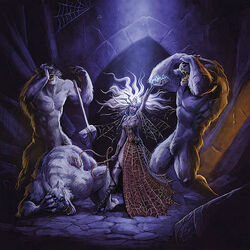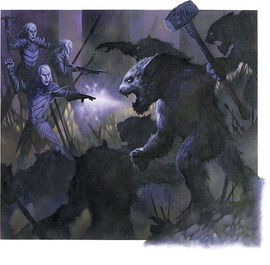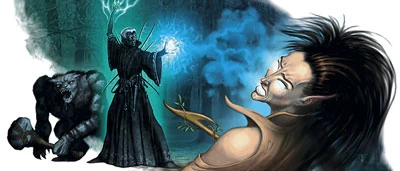Quaggoths (pronounced: /ˈkwægʌθ/ KWÆG-uth[8]), sometimes called deep bears,[3] were a species of vaguely bear-like humanoid that inhabited the Underdark.[2]
Description[]

A drow cleric of Lolth inflicting profane agony on a trio of quaggoths.
Quaggoths were tall and bulky humanoids with beast-like features. They had long, shaggy, white hair covering their entire bodies,[5] and some painted their fur to better camouflage into their Underdark homes.[3] They wore no clothing, with the leaders of packs being the exception.[5]
Personality[]
Quaggoths feared no creature. Warlike and vicious, they roamed the Underdark looking for prey. They hated the drow as well as surface-dwelling elves and dwarves.[5]
Combat[]
Quaggoth tribes claimed a certain territory as theirs and patrolled it, hunting for food. Any animals or creatures (such as a party of adventurers) detected invited certain attack.[5] They laid ambushes when the opportunity presented itself. Quaggoths attacked with either their claws or a crude weapon, depending on the clan. They were prone to flying into berserk rages, disregarding any weapons in favor of trying to tear their foes to pieces.[3]
Most poisons were ineffective against them.[5]
Society[]
Though they were dangerous hunters, quaggoths were just as often prey for other predators of the Underdark, particularly those like the drow or illithid with magic at their disposal. About half of all quaggoths lived in slavery.[3] Quaggoths could be trained as servants and guards if captured young.[5] Drow sometimes enslaved them as guards and spider handlers, while illithids used them as expendable soldiers. Slavery ground down a quaggoth's will to live, and they were known to exhibit something of a death wish in combat.[3]
Free quaggoths were nomadic hunters. They changed territories periodically. In each new territory, they claimed a central cave as a lair, leaving treasure with a few guards. The rest of the tribe hunted, returning periodically to rest and change guards. Quaggoth leaders were called jalds, and quaggoth shamans were called thonots and often made use of psionics.[5]
There were two broad cultural traditions among free quaggoths. Between 50%[3] and 70%[5] were known as "beast-followers", so named because they embraced their more animalistic natures. They rejected any pretensions of civilization, eschewing such basics as cooking their meat or using weapons in combat, instead relying much more on their race's natural rage and ferocity. The other tradition, known as "magic-followers" or otherwise as those who valued "improving on what nature gave us", would cook their food and utilize basic tactics in combat such as preparing tactical retreats. Only magic-followers would wield weapons and paint or dye their white fur for better camouflage.[3] They preferred stone clubs or axes, although quaggoths who had previously been drow slaves carried superior weapons, such as steel battleaxes or two-handed swords.[5] About one-fifth of quaggoth clans included both beast- and magic-followers, while the remainder ascribed to only one tradition.[3]
Crafts[]
Quaggoths produced few tools save for crude stone weapons and implements, and made little art aside from necklaces of bone and beads.[5]
Diet[]
Quaggoths were carnivorous, and would eat humanoids such as humans or dwarves despite not being fond of their taste.[3] They were known to claim all corpses after a fight—including those of fallen clan members—to be eaten, and would ritualistically devour their dead following last rites.[5]
Language[]
Quaggoths spoke a halting form of Undercommon, and could communicate only simple concepts.[5] Their speech often sounded more like barking and snarling than talking.[3] More intelligent quaggoths could also speak a few words of the Duergar, Drow, or Common languages.[5]
Religion[]
The psionic thonots oversaw most quaggoth rituals and traditions.[5] Some quaggoths were said to worship primal spirits, and sought out places of primal power.[2] Others had been reported to worship aspects of Malar.[9]
History[]

Quaggoths close in on a band of drow.
The origin of the quaggoths was unknown. Some believed they were once a surface-dwelling race driven underground, while others claimed they had been bred by drow magicians as a slave race before escaping to fill their own niche in the Underdark. Some sages claim that they were once a semi-civilized race that dominated much of the Underdark through conquest and ritual sacrifice, until the drow, duergar, and other races broke their power.[5] They did, however, have an underground kingdom called Ursadunthar, deep beneath the Spine of the World, until it fell to duergar from Gracklstugh in the −1350 DR[2] in the Deepbear Battles.[10]
By the 14th century DR, a population of quaggoths, orcs, and half-breeds (called boogins) had arisen in the Underdark beneath the Trollmoors. They referred to themselves as the "spider killers" in recognition of their constant struggle to resist drow incursions.[3]
Notable Quaggoths[]
- Derendil, a quaggoth touched by the madness of Fraz-Urb'luu who believed himself to be an elven prince.[11]
Appendix[]
| This article is incomplete. You can help the Forgotten Realms Wiki by providing more information. |
Appearances[]
Adventures
Novels & Short Stories
Video Games
Board Games
Further Reading[]
- Bruce R. Cordell, Gwendolyn F.M. Kestrel, Jeff Quick (October 2003). Underdark. (Wizards of the Coast). ISBN 0-7869-3053-5.
References[]
- ↑ Mike Mearls, Jeremy Crawford, Christopher Perkins (2014-09-30). Monster Manual 5th edition. Edited by Scott Fitzgerald Gray. (Wizards of the Coast), p. 256. ISBN 978-0786965614.
- ↑ 2.0 2.1 2.2 2.3 Bruce R. Cordell, Gwendolyn F.M. Kestrel, Jeff Quick (October 2003). Underdark. (Wizards of the Coast), p. 152. ISBN 0-7869-3053-5.
- ↑ 3.00 3.01 3.02 3.03 3.04 3.05 3.06 3.07 3.08 3.09 3.10 3.11 3.12 3.13 James Wyatt, Rob Heinsoo (February 2001). Monster Compendium: Monsters of Faerûn. Edited by Duane Maxwell. (Wizards of the Coast), p. 75. ISBN 0-7869-1832-2.
- ↑ 4.0 4.1 Ari Marmell, Anthony Pryor, Robert J. Schwalb, Greg A. Vaughan (May 2007). Drow of the Underdark. (Wizards of the Coast), pp. 136–139. ISBN 978-0-7869-4151-3.
- ↑ 5.00 5.01 5.02 5.03 5.04 5.05 5.06 5.07 5.08 5.09 5.10 5.11 5.12 5.13 5.14 5.15 5.16 Greenwood, Martin, Grubb (1993). Forgotten Realms Campaign Setting 2nd edition (revised), Monstrous Compendium. (TSR, Inc). ISBN 1-5607-6617-4.
- ↑ Don Turnbull (1981). Fiend Folio. (TSR Hobbies), p. 74. ISBN 0-9356-9621-0.
- ↑ Richard Baker and James Wyatt (2004-03-13). Monster Update (Zipped PDF). Web Enhancement for Player's Guide to Faerûn. Wizards of the Coast. p. 6. Archived from the original on 2016-11-01. Retrieved on 2018-09-10.
- ↑ Frank Mentzer (January 1985). “Ay pronunseeAYshun gyd”. In Kim Mohan ed. Dragon #93 (TSR, Inc.), p. 28.
- ↑ Brian R. James (April 2010). “Realmslore: Vaasa”. In Chris Youngs ed. Dungeon #177 (Wizards of the Coast) (177)., p. 80.
- ↑ Brian R. James, Ed Greenwood (September 2007). The Grand History of the Realms. Edited by Kim Mohan, Penny Williams. (Wizards of the Coast), p. 8. ISBN 978-0-7869-4731-7.
- ↑ Christopher Perkins, Adam Lee, Richard Whitters (September 1, 2015). Out of the Abyss. Edited by Jeremy Crawford. (Wizards of the Coast), p. 6. ISBN 978-0-7869-6581-6.

